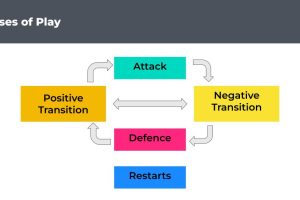Fitness Conditioning for Non-League Players: Tips and Strategies
Fitness conditioning is an essential aspect of any athlete’s training regimen. It involves a combination of strength, endurance, speed, agility, and recovery training to enhance an athlete’s overall performance. Non-league players are no exception to this rule, and their conditioning program should be tailored to their specific needs.
Understanding fitness conditioning is key to designing an effective training program. It involves a combination of aerobic and anaerobic exercises that focus on building strength, endurance, and agility. Strength training is crucial for building explosive power, while endurance training helps players maintain their stamina throughout the game. Speed and agility training are also essential for non-league players who need to be able to move quickly and change direction with ease.
Key Takeaways
- Fitness conditioning is essential for non-league players to enhance their overall performance.
- Strength, endurance, speed, and agility training are crucial components of a conditioning program.
- Recovery, nutrition, and injury prevention are also important factors to consider when designing a conditioning program.
Understanding Fitness Conditioning
Fitness conditioning is a process in which stimuli are created by an exercise program performed by the athlete to produce a higher level of function. The goal of conditioning is to optimize the athlete’s physical and mental performance in their sport. In football, conditioning is a vital aspect of training that helps players to achieve their maximum potential.
Conditioning involves a combination of exercises that target different aspects of physical fitness, including strength, endurance, speed, agility, and flexibility. The conditioning program should be tailored to the individual athlete’s needs, taking into account their age, fitness level, position, and injury history.
Coaches play a crucial role in designing and implementing an effective conditioning program for their players. They should have a good understanding of the principles of conditioning and be able to apply them to the specific requirements of football. Coaches should also be knowledgeable about the latest research and developments in the field of sports conditioning to ensure that their players are getting the best possible training.
In addition to physical conditioning, players also need to be mentally prepared for the demands of football. Mental conditioning can help players to stay focused, motivated, and confident, even under pressure. Techniques such as visualization, positive self-talk, and goal-setting can be used to enhance mental toughness and resilience.
Overall, fitness conditioning is a crucial aspect of football training that can help players to reach their full potential. With the right conditioning program, players can improve their physical and mental performance, reduce the risk of injury, and achieve their goals on the field.
Importance of Strength and Endurance
Strength and endurance are two crucial components of fitness conditioning for non-league players. Both of these attributes are essential for optimal performance and injury prevention.
Strength training involves lifting weights or performing bodyweight exercises to increase muscle mass, power, and strength. Squats and deadlifts are two of the most effective exercises for building lower body strength. Meanwhile, push-ups and pull-ups are great for building upper body strength.
Endurance training, on the other hand, involves activities that improve cardiovascular fitness, such as running, cycling, or swimming. It helps players maintain a high level of performance throughout the game and reduces the risk of fatigue-related injuries.
Combining strength and endurance training can lead to significant improvements in overall fitness. Studies have shown that strength training can improve endurance performance by increasing muscle power and efficiency. Similarly, endurance training can improve strength by increasing muscle fiber recruitment and improving muscular endurance.
Non-league players can benefit from incorporating both types of training into their fitness routine. A balanced training program that includes both strength and endurance training can help players achieve optimal performance and reduce the risk of injury.
It is important to note that strength and endurance training should be tailored to the individual player’s needs and abilities. A qualified fitness professional can help design a program that is safe and effective for each player.
In conclusion, strength and endurance are essential components of fitness conditioning for non-league players. A balanced training program that includes both types of training can lead to improved performance and injury prevention.
Speed and Agility Training
Speed and agility training are essential components of fitness conditioning for non-league players. Improving an individual’s speed and agility can enhance their performance on the field, reduce the risk of injury, and improve overall fitness.
Sprints and Running
Sprints and running are essential for improving speed. Sprint training can help non-league players improve their maximum speed and running speed. A sprint test can be used to measure an individual’s maximum speed. Non-league players should aim to incorporate sprint training into their workout routine at least once a week.
Agility
Agility is the ability to change direction quickly without losing speed, coordination, balance, or strength. Agility training can help non-league players improve their ability to move quickly and change direction on the field. Lateral movements, such as side shuffles and carioca sideways running, can be used to improve agility.
Plyometrics
Plyometrics are exercises that involve explosive movements, such as jumping and bounding. Plyometric training can help non-league players improve their speed and agility by increasing their power and explosiveness. Examples of plyometric exercises include box jumps, hurdle hops, and depth jumps.
Conditioning
Conditioning is an essential component of speed and agility training. Non-league players should aim to incorporate cardiovascular exercises, such as running, biking, or swimming, into their workout routine to improve their overall fitness. Interval training can also be used to improve endurance and speed.
Overall, speed and agility training should be an essential component of fitness conditioning for non-league players. By incorporating sprint training, agility training, plyometrics, and conditioning into their workout routine, non-league players can improve their performance on the field and reduce the risk of injury.
Role of Recovery in Conditioning
Recovery is an essential part of fitness conditioning for non-league players. After intense training or matches, players need to rest and recover to allow their bodies to repair and rebuild muscle tissue. Recovery helps reduce the risk of injury, improves performance, and enhances overall well-being.
There are several types of recovery that non-league players can use to aid in their conditioning. These include:
- Active recovery: This involves low-intensity exercise after a workout or match. Active recovery helps increase blood flow to the muscles, which aids in the removal of waste products and the delivery of nutrients to the muscles.
- Passive recovery: This involves rest and relaxation, such as taking a nap or getting a massage. Passive recovery allows the body to rest and repair itself, reducing the risk of injury and improving performance.
- Hydration: Proper hydration is crucial for recovery. Drinking enough water helps the body flush out waste products and maintain proper function.
- Nutrition: Eating a balanced diet that includes protein, carbohydrates, and healthy fats is essential for recovery. Proper nutrition helps repair and rebuild muscle tissue and provides the energy needed for intense training and matches.
Non-league players should also incorporate rest days into their training schedule to allow their bodies to recover fully. Short-term recovery involves low-intensity exercise after working out and during the cool-down phase. Long-term recovery refers to recovery periods that are built into a seasonal training schedule and may include days or weeks incorporated into an annual athletic program.
In conclusion, recovery is a crucial component of fitness conditioning for non-league players. Proper recovery helps reduce the risk of injury, improve performance, and enhance overall well-being. Non-league players should incorporate different types of recovery, including active and passive recovery, hydration, and nutrition, into their training schedule to aid in their conditioning.
Position Specific Conditioning
In addition to general fitness conditioning, non-league players should also focus on position-specific conditioning to enhance their performance on the pitch. Position-specific conditioning involves tailoring training to the specific demands of a player’s position, taking into account the physical, technical, and tactical requirements of the position.
Goalkeeper Conditioning
Goalkeepers require a unique set of physical attributes, including explosive power, agility, and quick reflexes. To develop these attributes, goalkeepers should focus on exercises that improve their reaction time, explosiveness, and core strength. Some examples of goalkeeper-specific exercises include:
- Plyometric exercises such as box jumps and lateral bounds to improve explosive power and agility
- Resistance band exercises to strengthen the muscles used in diving and jumping
- Medicine ball exercises to improve core strength and stability
Attacking Player Conditioning
Attacking players require a high level of fitness, speed, and agility to be effective on the pitch. To improve their performance, attacking players should focus on exercises that improve their speed, agility, and endurance. Some examples of attacking player-specific exercises include:
- Interval training to improve speed and endurance
- Cone drills to improve agility and footwork
- Resistance band exercises to improve explosiveness and power
Movement Conditioning
All players, regardless of position, require good movement conditioning to be effective on the pitch. Movement conditioning involves developing the ability to move efficiently and effectively in all directions. Some examples of movement conditioning exercises include:
- Ladder drills to improve footwork and coordination
- Agility drills to improve quickness and change of direction
- Plyometric exercises to improve explosiveness and power
By incorporating position-specific conditioning into their training routines, non-league players can improve their performance on the pitch and give themselves an edge over the competition.
Pre-Season Conditioning
Pre-season conditioning is a crucial aspect of fitness training for non-league players. It is a period where players prepare themselves physically and mentally for the upcoming season. The pre-season period usually lasts for 6-8 weeks and consists of a combination of aerobic and anaerobic exercises, strength training, and skill-specific drills.
During the pre-season, players must focus on building their endurance, strength, and agility. This is achieved through a combination of rowing, running, and other cardiovascular exercises. It is important to start with low-intensity workouts and gradually increase the intensity as the pre-season progresses. Players should also repeat the same workouts over time to improve their fitness levels.
Strength training is another important aspect of pre-season conditioning. Players should focus on building their core strength, as well as their upper and lower body strength. This is achieved through a combination of weightlifting, bodyweight exercises, and resistance training. It is important to focus on proper form and technique to prevent injuries.
Skill-specific drills are also an important part of pre-season conditioning. Players should focus on improving their technical skills, such as passing, shooting, and dribbling. They should also work on their tactical awareness, such as positioning and movement on the field.
In summary, pre-season conditioning is a crucial period for non-league players. It is a time to build endurance, strength, and agility through a combination of aerobic and anaerobic exercises, strength training, and skill-specific drills. Players should focus on repeating workouts, maintaining proper form and technique, and improving their technical and tactical skills.
Injury Prevention and Management
Injuries are unfortunately a common occurrence in sports, including non-league play. Therefore, it is essential for players to take steps to prevent injuries and know how to manage them when they do occur.
Injury Prevention
Preventing injuries should be a top priority for non-league players. The following strategies can help reduce the risk of injury:
- Proper Warm-Up: Before any physical activity, players should warm up their muscles to increase blood flow and flexibility. This can include light cardio and dynamic stretching.
- Strength and Conditioning: Building strength and endurance can help prevent injuries by improving overall fitness. Exercises that target the core, legs, and upper body can be particularly beneficial.
- Proper Technique: Using proper form and technique can help prevent injuries. Players should focus on maintaining good posture and avoiding overextension or overexertion.
- Rest and Recovery: Rest and recovery are essential for preventing injuries. Players should take breaks between games and practices and get enough sleep to allow their bodies to recover.
Injury Management
Even with preventative measures, injuries can still occur. It is important for players to know how to manage injuries to prevent further damage. The following steps can help:
- Stop Playing: If a player experiences pain or discomfort during a game or practice, they should stop playing immediately.
- RICE Method: The RICE method (Rest, Ice, Compression, Elevation) can be used to manage many types of injuries. Rest the affected area, apply ice to reduce swelling, compress the area with a bandage, and elevate the injured limb above heart level.
- Seek Medical Attention: For more serious injuries, players should seek medical attention. This can include consulting with a doctor, physical therapist, or athletic trainer.
By taking steps to prevent injuries and knowing how to manage them, non-league players can stay healthy and continue to enjoy their sport.
Nutrition and Body Composition
Proper nutrition is crucial for non-league players to maintain optimal body composition and perform at their best. Body composition refers to the proportion of fat, muscle, and other tissues in the body. It is essential for players to maintain a healthy body fat percentage to improve their performance and reduce the risk of injury.
Athletes should aim for a balanced diet that includes carbohydrates, protein, and healthy fats. Carbohydrates are the primary source of energy for athletes, and they should make up the majority of their diet. Non-league players should consume complex carbohydrates, such as whole grains, fruits, and vegetables, to sustain energy levels throughout the day.
Protein is essential for muscle repair and growth, and athletes should aim to consume 1.2-2.0 grams of protein per kilogram of body weight per day [1]. Good sources of protein include lean meats, fish, eggs, and plant-based sources such as beans and legumes.
Healthy fats are also important for athletes and should make up around 20-30% of their diet. Non-league players should aim to consume unsaturated fats, such as those found in nuts, seeds, avocado, and olive oil.
In addition to macronutrients, athletes should also pay attention to their micronutrient intake. Vitamins and minerals play a crucial role in maintaining overall health and preventing illness. Non-league players should aim to consume a variety of fruits and vegetables to ensure they are getting adequate amounts of essential vitamins and minerals.
Finally, hydration is essential for athletes to maintain optimal performance. Non-league players should aim to drink at least 8-10 glasses of water per day and consume additional fluids during and after exercise to replace fluids lost through sweat.
Maintaining optimal body composition is also crucial for non-league players. Excess body fat can negatively impact performance and increase the risk of injury. Non-league players should aim to maintain a body fat percentage between 6-18% for men and 16-24% for women [2].
Players can monitor their body composition through various methods, including skinfold measurements, bioelectrical impedance analysis, and dual-energy X-ray absorptiometry (DXA) scans. It is essential to work with a qualified professional to ensure accurate measurements and interpretation of results.
In summary, proper nutrition and body composition are essential for non-league players to perform at their best and reduce the risk of injury. Athletes should aim for a balanced diet that includes complex carbohydrates, protein, healthy fats, and essential vitamins and minerals. They should also aim to maintain a healthy body fat percentage through regular monitoring and working with qualified professionals.
[1] Sports Nutrition: Diets, Selection Factors, Recommendations. https://www.ncbi.nlm.nih.gov/pmc/articles/PMC8619485/
[2] Assessment of Body Composition in Athletes: A Narrative Review of… https://www.ncbi.nlm.nih.gov/pmc/articles/PMC8150618/
Conditioning for Non-League Players
Conditioning is an essential part of a non-league football player’s training regime. It helps players to improve their endurance, strength, and agility, which are crucial for performing well on the pitch.
Non-league players can benefit from a variety of exercises that can be done both on and off the pitch. One such exercise is running, which can help to improve a player’s cardio endurance. Running for at least 30 minutes a day is recommended for non-league players, as it helps to build stamina and endurance.
In addition to running, non-league players can also perform a 10-minute routine at home that will greatly enhance their cardio endurance. This routine involves performing three sets of 10 burpees interspersed with 3 x 20 star jumps and 3 x 10 high knees.
Lifting weights is also an important part of building explosive power if a non-league player is serious about bringing their game on. Players should focus on compound lifts such as squats and deadlifts, which engage multiple muscle groups and help to build overall strength.
It is important to note that conditioning programs should be tailored to the individual player’s needs and goals. Academy players, for example, may require a more intense conditioning program than non-league players, as they are preparing for higher levels of competition.
Overall, conditioning is an essential part of a non-league player’s training regime. By incorporating a variety of exercises into their routine, non-league players can improve their endurance, strength, and agility, and ultimately perform better on the pitch.
Conclusion
In summary, regular physical activity is essential for non-league players looking to improve their performance on the field. Engaging in a conditioning program can help players build strength, endurance, and explosive power, which are all critical for success in the sport.
The first phase of a conditioning program typically involves building a solid foundation of fitness through exercises with lighter loads. This phase may last from 2-6 weeks, depending on the athlete’s training history and how long they have until the competitive season. Untrained athletes may require more time in this phase.
The second phase of a conditioning program involves performing specific exercises with greater loads, comprising 75-90% of 1RM. This phase is critical for building explosive power and should be tailored to the specific needs of the player.
In addition to improving physical fitness, regular physical activity can also produce improvements in cognitive performance and psychological well-being. Physical benefits include reduced risk for diseases, improvements in physical functioning, fitness, and overall quality of life.
Coaches play a critical role in assessing players’ physical performance and ensuring that conditioning programs are appropriately graded to protect against injury. The appropriately graded prescription of high training loads should improve players’ fitness, which in turn may protect against injury, ultimately leading to greater physical outputs.
Overall, non-league players who engage in regular physical activity and follow a well-designed conditioning program are more likely to perform at their best on the field and enjoy a range of physical and mental health benefits.
Frequently Asked Questions
What are some effective fitness conditioning exercises for non-league football players?
Non-league football players can benefit from a variety of fitness conditioning exercises. Some effective exercises include burpees, star jumps, high knees, and weightlifting. These exercises can help improve cardio endurance, explosive power, and overall strength.
How can lower league footballers improve their endurance for a full 90-minute game?
To improve endurance for a full 90-minute game, lower league footballers should focus on building their aerobic fitness through regular cardio exercise. Running, cycling, and swimming are all effective ways to improve endurance. Additionally, interval training can help improve both aerobic and anaerobic fitness.
What are some recommended pre-season training programs for non-league football players?
A recommended pre-season training program for non-league football players should focus on building strength, endurance, and agility. This can be achieved through a combination of cardio exercise, weightlifting, and agility drills. It is also important to gradually increase training intensity and volume to avoid injury.
How can non-league footballers improve their strength and power in the gym?
To improve strength and power in the gym, non-league footballers should focus on compound exercises such as squats, deadlifts, and bench presses. These exercises target multiple muscle groups and can help build overall strength. Additionally, plyometric exercises such as box jumps and medicine ball throws can help improve explosive power.
What are some key fitness requirements for lower league footballers?
Lower league footballers require a combination of aerobic and anaerobic fitness, strength, power, agility, and endurance. It is important to focus on building these fitness components through regular exercise and training.
What are some tips for managing fitness and conditioning as a non-league football player?
To manage fitness and conditioning as a non-league football player, it is important to have a structured training program that includes regular exercise and rest days. Additionally, proper nutrition and hydration are essential for optimal performance and recovery. It is also important to listen to your body and adjust training intensity and volume accordingly to avoid injury.






